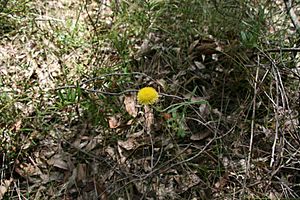Button everlasting facts for kids
Quick facts for kids Button everlasting |
|
|---|---|
 |
|
| Scientific classification | |
| Kingdom: | |
| (unranked): | |
| (unranked): | |
| (unranked): | |
| Order: | |
| Family: | |
| Genus: |
Coronidium
|
| Species: |
C. scorpioides
|
| Binomial name | |
| Coronidium scorpioides (Labill.) Paul G.Wilson
|
|
| Synonyms | |
|
Helichrysum scorpioides Labill. |
|
The Coronidium scorpioides, often called the button everlasting, is a small shrub found in Australia. It's a type of plant that lives for many years. This plant belongs to the Asteraceae family, which includes daisies and sunflowers.
Before 2008, this plant was known by a different name, Helichrysum scorpioides. But scientists decided to give it a new name, Coronidium scorpioides, when they created a new group of plants called Coronidium.
About Its Name
A French scientist named Jacques Labillardière first described the button everlasting in 1806. He called it Helichrysum scorpioides. He found a sample of the plant in Tasmania.
Later, scientists realized that the large group of Helichrysum plants contained many different types that weren't closely related. So, they started moving some of these plants into new groups.
In 2008, a botanist named Paul Graham Wilson created a new group, or genus, called Coronidium. This new group included 17 types of daisy-like plants from eastern Australia. That's when the button everlasting got its new name, C. scorpioides. Wilson thinks there might be even more types of C. scorpioides that could be named separately in the future.
What It Looks Like
The button everlasting is a perennial plant, meaning it lives for more than two years. It grows from a strong, woody root. The plant usually reaches about 20 to 50 centimeters (8 to 20 inches) tall.
Its stems are covered in a soft, woolly fuzz and grow straight up without branching. In the spring, bright yellow flowerheads bloom at the top of these stems, looking a bit like small buttons.
Where It Lives
You can find Coronidium scorpioides in several parts of Australia. It grows from the Gibraltar Range in northern New South Wales, down through the eastern part of that state, into Victoria, and southeastern South Australia. It also lives in Tasmania.
This plant prefers richer, heavier soils. These soils are often made of brown clay or clay-loam. You can find it growing in open forests. It often grows under trees like the narrow-leaved peppermint, Sydney peppermint, brown barrel, grey gum, manna gum, or Blaxland's stringybark. It can also be found in more open woodlands, under trees like scribbly gum and narrow-leaved apple.
How It Survives
The button everlasting is very tough, especially when it comes to bushfires. After a bushfire, the plant can grow back from its roots. Some plants can even start to flower again in as little as 16 weeks after a fire.

